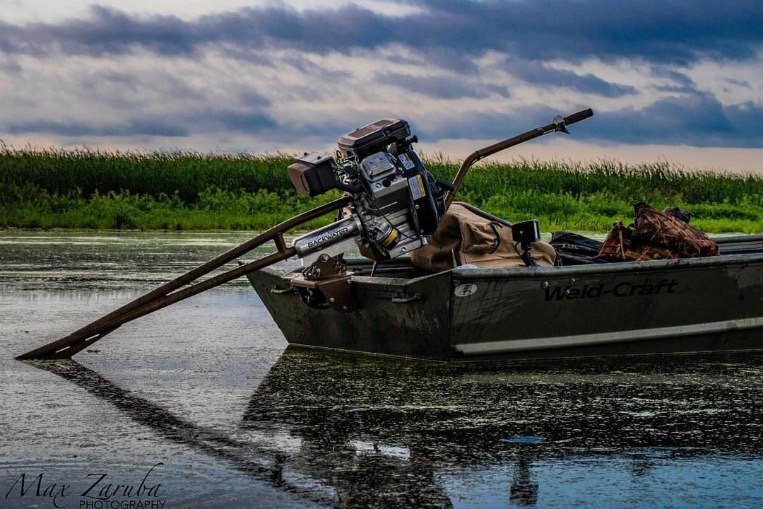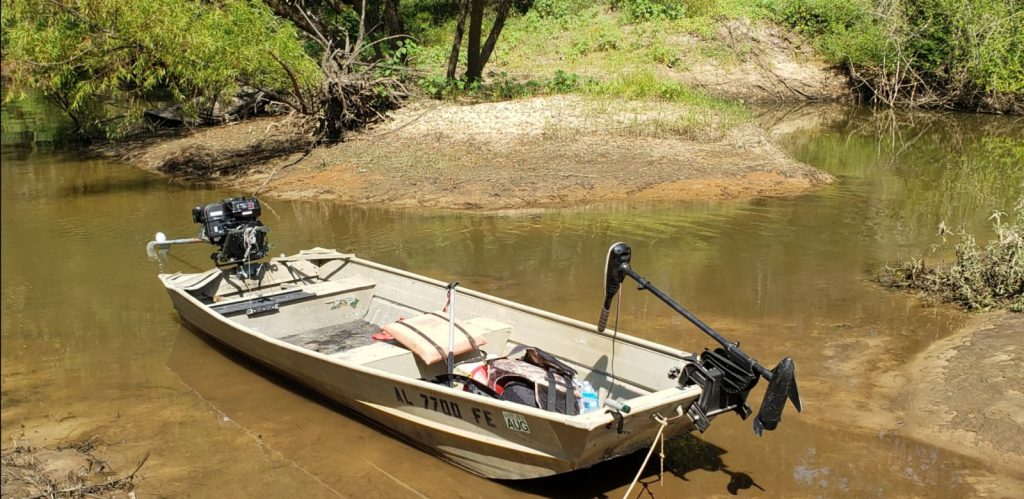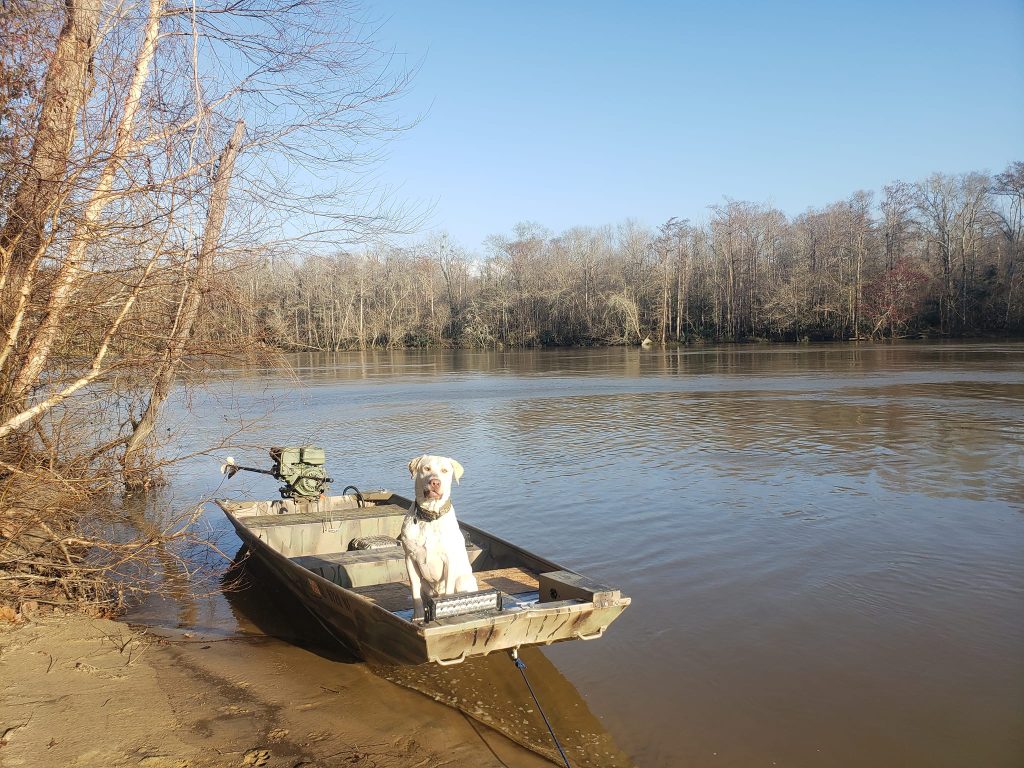Several years ago, I got tired of tinkering with old Johnson and Evinrude 2-strokes. The ones that I could afford always had something that needed doing. The carb float would stick. The jets would clog. The water impeller would come apart. The points and condensers would need replacing. Every year, I’d spend a few weekends turning bolts or waiting on (increasingly hard to find) parts to come in instead of hunting and fishing. I’d often observe angrily to nobody in particular that if I wanted to fish, obviously the boat motor couldn’t be bothered to start. But the lawn mower? Turns over on the first pull, of course! Then I had an epiphany. Why not power my boat with a lawn mower engine? Or at least an air cooled, modern four stroke? Mud motor kits were inexpensive, parts were readily available and cheap, and everything that needed maintenance was easily accessible.
I was familiar with the big, name brand mud motors like Go-Devil, Mud Buddy, and Beaver Tail, but those were overkill for both my little 14 footer and my wallet. I turned to the internet looking for build-it-yourself ideas, and found out that several manufacturers existed who offered kits that included the transom mount, shaft, handle, prop, and throttle controls. All you needed was some basic mechanical knowledge, a wrench, and a motor, and you were off to the races with a brand new boat motor for right at a grand.
I killed probably a couple of hundred hours researching long tail mud motor kits, purchased one, built it, and used it for three seasons hunting and fishing Mobile Bay and the Mobile-Tensaw Delta. By the time I parted ways with mine, I had logged over 500 hours on it per the tachometer I installed. In this article, I’m going to tell you what I’d recommend looking for if you’re looking for an affordable and practical way to power your boat.
Factors To Consider When Buying A Long Tail Mud Motor Kit
Before you commit to buying a mud motor kit, you should know what these kits are not. They’re not fast. You’ll read about tweaking the shaft length and the importance of trimming your cargo weight and selecting a narrow hull. These things make very minor differences in top-end speed. At the end of the day, you’ll never touch the speed an similarly-sized outboard will give you. My 420cc (13hp) mud motor on a 1436 hull would give me about 20mph with just me and a light load in it. A 212cc (9.9hp) Mercury gives me the same speed with less weight and much less noise.
These kits are also not for big boats. The biggest kit you’ll find is for a 670cc (22hp) v-twin motor. In my experience, and in talking with other users at the ramp, a 1648 hull is about as big of a boat as you can push without feeling a little underwhelmed. So if you’re looking to haul multiple hunters and lots of gear in a big, nice boat with a built-in blind, a cooler full of drinks, and a hunting dog, you’re barking up the wrong tree.
Finally, long tail mud motors are not “nice” to use. They will vibrate your hand until it goes numb if you drive them for too long. They’re so loud that you really should wear ear protection while operating them. They lack reverse and neutral gears (or any gears, for that matter). They’re a pain to turn in tight water, and a pain to trailer. You also have to find a way to strap that long tail down inside your boat when you’re going down the road, which will one day be more irritating than you think it will be.
Where these motors shine is on the transoms of small, cheap, jon boats that are getting used hard by people who are on a budget and know that they are rough on gear. Me and my boat fit that criteria. If you do too, you’ll probably be happy with your purchase.
Build Quality
Once you’ve decided that you want to build a long tail kit, the first thing to look for is build quality. The nicest kit I’m aware of, by far, is the Backwater line of SWOMP kits. I have had the chance to examine several Backwater kits up close at the ramp after duck hunting, and their build quality is impeccable. They’re US-made, use better metal, have better welds, and are just really well designed. They have much less “shake, rattle, and roll” than some of the cheaper overseas kits, but despite feeling much stouter they’re much lighter and more “refined” feeling. If you’ve got the budget, I’d strongly recommend Backwater.

Another nice, US-made option for hunters powering smaller boats is the PPF Wood Duck Kit. They only make it to fit a 212cc motor, so it’s not for everybody, but if you’re looking for a super lightweight kit that you can take on and off a canoe or small jon boat, you won’t find a better alternative.
While I have a lot of admiration for these kits, I didn’t spring for one. I went with a Swamprunner kit, which I regard along with Beaver Dam as a middle-of-the-road option. These kits are made in Thailand, and are appreciably cheaper than American kits. Mine was perfectly functional, but had a very “third world” feel. Parts were cast instead of milled, the hardware was soft, and there were little downgrades for the sake of cutting cost such as wooden bushings that the shaft rode on. Cutting-edge metallurgy the frame wasn’t, but there was enough of whatever pot metal they used that it never broke. It was heavy though, and there was a noticeable flex in the handle. My biggest concern, although it never happened, was that the weight of the 8ft shaft would crack the cast crankcase side cover it was bolted to. If you shop around, you’ll notice that most American designs do brace this connection somehow.
At the lowest end of the build quality spectrum, in my opinion, are the kits made by Mud Skipper. While they share the general design of most other Thai kits, the parts are thinner almost across the board. At the time that I purchased mine, there seemed to generally be more unfavorable user reviews of these floating around compared to the other import kits. But, to be fair, it looks like they’ve made some recent changes to their design, such as adding bracing to the shaft/crankcase joint.
I would say that generally, build quality becomes more important the bigger your power source and hull. A 670cc motor pushing a large 16ft welded boat through mud puts a lot more stress on a frame than a little 212cc scooting a 12ft riveted boat across a beaver pond or down a shallow creek.
Engine Power And Size
The second consideration is engine size. Long tails are very heavy compared to outboard engines. They’re also much more torquey, and can put “weird” stress on a transom due to extreme vibration and the leverage the long handle and even longer shaft provide. All of this means that the horsepower rating your boat came with isn’t necessarily accurate. My boat, for example, was rated for a 25hp outboard. I put a 13hp long tail kit on it, and would not have wanted to go much higher. In general, roughly half of what your transom is rated for should give you good freeboard and maximum chance that you don’t develop a crack after a few hundred hours.
Choosing The Best Mud Motor Engine
Ultimately, the kit is only half of your mud motor. The engine is an equally important component. The mud motor kits themselves are relatively simple, problem-free hardware if treated right. But the engine…it can give you some problems.
The “premium” engine choice for a kit would be either a Honda or a Briggs and Stratton Vanguard. The Vanguard 16 and 18hp engines in particular are popular since they’re American-made V-twins that have an excellent weight-to-power ratio. If you’re getting a larger-sized kit, a v-twin gives you more horsepower and less vibration due to the two cylinders balancing each other out as opposed to a single-banger creating a “shakeweight” effect. You’ll also see Honda engines listed as “upgrades” on a lot of mud motor websites.

But by far the most popular engines for mud motor kits are the Harbour Freight exclusive Predator engines. I powered my kit with one, and I have to say that I was really shocked at how well the motor ran at its price point. I put over 500 hours on it, and sold it to a local kid who I occasionally run into out on the river. It never gave me any problems, and if it’s given him any he hasn’t mentioned it. I bought a completely assembled spare carburetor for the engine for about $20 just in case it gave me issues, planning to simply replace it instead of rebuilding it, but I never needed it. I installed a cheap tachometer, changed the oil every 50 hours or so, and that was the extent of engine maintenance for 3 years. When I sold the motor it still had the original spark plug and air filter, and both were clean and in good shape.
On my 1436, I had the 420cc, 13hp Predator. I would say that for a smaller boat, the 212cc would be a good fit. On a 1648, the largest I’d personally use a kit on, a 670cc would be appropriate. They didn’t have it when I purchased mine, but Harbor Freight also currently offers a 459cc, 16hp engine that has the same physical weight as my old 420cc. If I was going to do it all over again, I’d bump up to that engine to get a little better top-end speed with a hunting buddy and a full load in the boat.
My Personal Experience With A Long Tail Mud Motor
With the basic information out of the way, I’ll give my personal review of the kit that I had.
First, I’ll start with what I liked. I was happiest with my motor during teal season. During teal season I hunt a lot of places that are relatively close to the launch but very shallow and sandy. Getting out to my spot in the dark and having such a short distance to run, the slow top-end speed wasn’t a handicap. Even the guys in bigger, more expensive rigs ran pretty slow in the morning fog! I also enjoyed an advantage over those guys since my lighter boat drafted less water, and my motor would push my boat across the sand bars as long as I could keep most of the prop in the water. On sand, horsepower only does so much. It’s very, very hard to muscle your way through sand. Bigger motors could run easier than I could in true mud, but I watched several hunters get left aground on sandbars where I still had just enough water to slide out.
The motor was also an excellent log hopper. With the prop eight feet behind the stern, I could apply power and adjust the angle I applied it at even when high-centered. I never once stuck it on a log, and I got pretty confident with it. As long as the nose of the boat would clear the top of the log, I could ease over it. This meant that I could get past jams that stopped a lot of other hunters and anglers and explore undisturbed parts of the creek.
I was “satisfied enough” with the motor when using it to get to and from my deer stand. I liked being able to get up in remote creeks, but if I had to run more than 2 or 3 miles up river the slow pace was noticeable. The engine was also loud enough that I would kill it a couple of hundred yards away and troll into my spot, which took even more time. It wasn’t terrible, but I definitely found myself missing an outboard. But for the money, it was much faster than paddling or trying to use a trolling motor to power a canoe like some of my other budget-restrained buddies.

I was least happy when using my motor to fish with my wife. Mainly because my wife did not find the roar and vibration to be very relaxing, and I could tell that it was diminishing the experience of being out on the water for her. I ended up mostly just using the trolling motor when we fished.
I also never got over the hassle of not having reverse and neutral. A 14ft boat can turn around in some pretty narrow creeks, but a long tail turns that 14ft boat into a 24ft boat. That’s definitely something to consider if you run a lot of creeks or use a busy ramp.
Ultimately, would I buy one again? If I hunted and fished a lot of shallow but open water, absolutely. But I eventually realized that most of my running was in 3ft of water or more, and that I spent more time in twisted creeks than open bays. Most importantly, I wanted my wife to enjoy the boat more. An outboard and a push pole ended up making more sense for me, but I haven’t ruled out one day owning another one. I really miss my old one every spring when I’m changing out the water pump and foot oil on the ole Merc’.
Final Thoughts On Long Tail Mud Motor Kits
Overall, long tail mud motor kits are an affordable and very utilitarian way to power a hunting and fishing boat. If you’re looking for a cheap way to get out on the water to chase ducks or fish the flats, they will definitely do that thing. They won’t set any speed records, but they’ll run shallow and even the mechanically-inept can keep them running. Paired with a small aluminum jon boat, they make an awesome first boat for somebody who has grown tired of paddling to their duck hole or fishing from the bank. I made a lot of good memories in mine, and if you decide to get one I”m sure you will too!
Full Disclosure: This post may include affiliate links. There’s no extra charge to our readers for using these.




